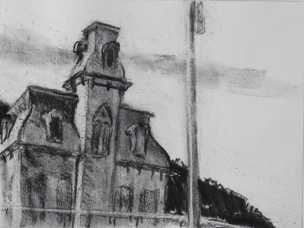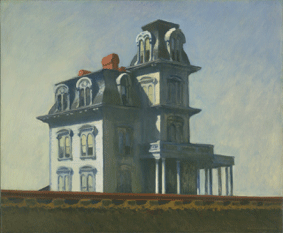From the Sheldon Swope Art Museum in Terre Haute, Indiana to the Museum of the Art Institute of Chicago and from the Museum of Modern Art in New York across town to the Whitney Museum of American Art, we can discover several iconic images of American life, all produced by the same artist: Edward Hopper.
Their sense of place and history not only documents an era in our national life, but also evokes the feel and texture of those years. These images have intrigued and inspired a variety of American poets and painters including both Edward Hirsch and Phillip Koch. They have also become iconic images that stand in for a much larger and more complex sense of our country: rooftops and storefronts, bridges and lighthouses, and of course railroad tracks and isolation.
For Phillip Koch many of these images are reminders of his own childhood and studies in art school, especially in New York, Ohio, and Indiana. Seeing and confronting Hopper’s paintings are one of the most important ways of learning, not only about them, but also about painting in general.
When I asked Phillip Koch about Hopper’s painting “House by the Railroad” this was his response:
“I’ve loved that painting for years and in March of 2015 made a special trip up to Haverstraw, NY (just north of Hopper’s hometown of Nyack, NY) as I knew the building Hopper had worked from was still standing and little changed from his day. The house is high up on a hill overlooking the Hudson River. There is a railroad track just down the hill a bit from the house, and still farther down the hill a road where Hopper stood and envisioned his painting.”

“Haverstraw”
2015
Vine charcoal on paper
10 1/2” x 14”
Collection of the artist, Baltimore, Maryland
“This is Haverstraw, vine charcoal, 10 1/2 x 14 inches, 2015, that I did from nearly the exact same spot where Hopper stood to do his House by the Railroad. I didn’t include the railroad tracks though they are still there and in use, just as in Hopper’s day. If you compare Hopper’s oil to my version, you can see Hopper felt free to invent some additional architectural features to make his structure more interesting (realist that he was, he loved to play around with his subjects and add and subtract forms at will.)”[i]
For the poet Edward Hirsch, Hopper’s paintings frame a mid-western sense of isolation: spatial and psychological conditions. Hirsch often personifies the typical American storefront, or an old house façade, giving them human expressions: these are some of the classic human conditions that poets constantly deal with, playing with only light and shadow and words and rhythms in order to intensify and exaggerate a mythical presence.
What follows here, is Hirsch’s articulate and sensitive meditation on Edward Hopper’s great painting, “House by the Railroad” from 1925:
Edward Hopper and the House by the Railroad
“Out here in the exact middle of the day,
This strange, gawky house has the expression
Of someone being stared at, someone holding
His breath underwater, hushed and expectant;
This house is ashamed of itself, ashamed
Of its fantastic mansard rooftop
And its pseudo-Gothic porch, ashamed
of its shoulders and large, awkward hands.
But the man behind the easel is relentless.
He is as brutal as sunlight, and believes
The house must have done something horrible
To the people who once lived here
Because now it is so desperately empty,
It must have done something to the sky
Because the sky, too, is utterly vacant
And devoid of meaning. There are no
Trees or shrubs anywhere—the house
Must have done something against the earth.
All that is present is a single pair of tracks
Straightening into the distance. No trains pass.

“House by the Railroad”
1925
Oil on canvas
24” x 29”
(Anonymous Gift)
Museum of Modern Art, New York
Now the stranger returns to this place daily
Until the house begins to suspect
That the man, too, is desolate, desolate
And even ashamed. Soon the house starts
To stare frankly at the man. And somehow
The empty white canvas slowly takes on
The expression of someone who is unnerved,
Someone holding his breath underwater.
And then one day the man simply disappears.
He is a last afternoon shadow moving
Across the tracks, making its way
Through the vast, darkening fields.
This man will paint other abandoned mansions,
And faded cafeteria windows, and poorly lettered
Storefronts on the edges of small towns.
Always they will have this same expression,
The utterly naked look of someone
Being stared at, someone American and gawky.
Someone who is about to be left alone
Again, and can no longer stand it.”[ii]
[i] Koch, Philip; An artist’s statement contained in an e-mail correspondence with this writer; 19 November 2017.
[ii] Hirsch, Edward; “Edward Hopper and the House by the Railroad (1925)” Wild Gratitude; Alfred A. Knopf Publishers; New York, New York; 1986; pp. 13-14.